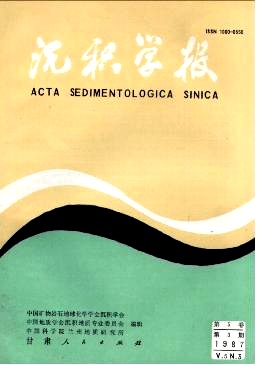THE GEOLOGICAL EVENTS AND ORE MINERALIZATION NEARBY THE PRECAMBRIAN-CAMBRIAN BOUNDARY IN YANGTZE PLATFORM
- Publish Date: 1987-09-10
Abstract: 1. The iridium anomaly and the rare event The iridium anomaly was discovered in the lower Cambrian Ni-Mo polyelement layers by means of Instrumental Neutron Activiation Analyse (INAA) in 1982. Since then systematic and detailed studies were made on 6 sections in Yangtze Platform. 67 samples were analysed by means of INAA and 17 iridium anomalies were found in different rocks, mostly Ni-Mo polyelement layers. It is noteworthy that high value of iridium in phosphatic and barite-pyrite concretions have also been discovered, indicating the reconcentration of iridium during the early diagenetic stage (Table 1). The abundance of the noble metals in the lower Cambrian Ni-Mo polyelement layers, the Cretaceous-Tertiary boundary clays, basalt and chondrite is listed in Table 2. Fig.2 shows the abundance of the noble metals relative to that of C1 chondrite. Most metals in Ni-Mo polyelement layers such as Os, Pt, Co and Pd have flat distribution pattern, but Ni and Au have a high concentration, Ir content is much low. The iridium anomaly has a wide distribution both in space and in time which extends intermittently about 1600 km on Yangtze Platform(Fig. 1). No.l is the Dayuan section in Guizhou Province where iridium anomaly is found in phosphorite, black dolomitic siltstone and Ni-Mo polyelement layer. No.2 is the Xintugou section in Guizhou Province, where high iridium content is found in phosphatic concretions and Ni-Mo polyelement layers. NO.3 is the Tianmenshan section in Hunan Province, where iridium anomalies are discovered in Ni-Mo polyelement layers and black muddy siliceous rock. No.4 is the Yanglingshan section in Jiangxi Province, where high iridium content are found in black siliceous rock and barite-pyrite concretion. No.5 is the Nanshan section in Jiangxi Province, but no iridium anomaly is found there. No.6 is the Jianglong section in Zhejiang Province, where iridium anomalies are discovered in phosphorite and Ni-Mo polyelement layer. Stratigraphically the layers of high concentration of iridium are located mainly about 30cm to 2m sometimes 5m or over, above the underlying dolostone. The iridium anomaly can be found in two types of sedimentary sequences and various rocks, which quite different from each other in sedimentary environment. So from mentioned above, the iridium anomaly would be interpreted as an indicator of a rare event, related to extraterrestrial factors. 2. Iridium and other polyelement concentrations Iridium coexists with more than 30 elements, in order to make clear the relations among them, more detailed studies were done in the Xintugou section. We collected 16 samples for INAA from the Xintugou section, with 1.56m in thickness. Plate I shows the geological occurrences of Ni-Mo polyelement layer (Gx115), underlying phosphatic lenticle (Gx114) and overlying black silty shale (Gx116) from Xintugou section. Plate I-2 indicates a sample of Ni-Mo polyelement ore, consisting of "clastic" sulfides (A1) with 7cm in thickness and limestone (A2) with 1cm in thickness. Using reflected light microscope, we have selected three samples for INAA which consist mainly of Ni-sulphides (a), Mo-sulphides (b) and Fe-sulphides (c) respectively. The result of INAA indicates the high content of iridium as well as those of Ni, Mo, Zn, As, Se, Co, Au (Tab.3, Fig.3), U and REE are concentrated mainly in Ni-Mo polyelement layers, phosphatic lenticles, concretions and phosphorite beds (Fig. 4, 5). It is noteworthy that the coexistence of the polyelements does not indicate that they have only one material source. In the light of their geochemical characterestics and the abundance in the crust and chondrite, we consider that the platinum metals, Au, Ni, Co, Se, as well as part of Fe would have mainly an extraterrestrial origin, whereas U, Th, Ba, REE, Zn, Sb etc. would come from the continent or ocean, especially from the hot springs, hot brines and volcanic eruptions. In the anoxic environment rich in sapropel and sulfur these multisource elements can coexist together. 3. Black shale series and anoxic event B
| Citation: | Fan Delian, Ye Jie, Yang Ruiying, Huang Zhongxiang. THE GEOLOGICAL EVENTS AND ORE MINERALIZATION NEARBY THE PRECAMBRIAN-CAMBRIAN BOUNDARY IN YANGTZE PLATFORM[J]. Acta Sedimentologica Sinica, 1987, 5(3): 81-95. |






 DownLoad:
DownLoad: